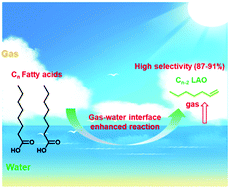Gas–water interface engineered exceptional photoconversion of fatty acids to olefins†
Abstract
Gas–water interface mediated photoconversion of renewable biomass into fuels is a promising strategy to mitigate the impending environmental pollution and energy crisis. Herein, a gas–water interface is engineered to photoconvert fatty acids (FAs, C6–C9) into gaseous Cn-2 linear alpha-olefins (LAOs) with a high selectivity (87–91%) under mild conditions; especially, experiments with different interfaces demonstrate that the gas–water interface plays a crucial role in the enhanced selective production. The thinner molecular layer and ordered packing significantly promote the production of LAOs by maximizing the hydrogen bonding between FAs and interfacial water molecules. Furthermore, density functional theory (DFT) calculations, at the molecular level, elaborate that interfacial water could activate the reactions through hydrogen bonding lowering the reaction barrier of initial photoreaction of FAs. Additionally, different atmospheres are found to impact the pathways and products of photoconversion, thus enabling the controllable synthesis of LAOs. Unlike the metal/enzyme-involved harsh catalytic system, the gas–water interface serves as a green, low-cost and efficient ‘venue’ which can be infinitely reused for hydrocarbon production, pioneering a new way for mitigating the energy crisis and developing a truly green and sustainable society.



 Please wait while we load your content...
Please wait while we load your content...